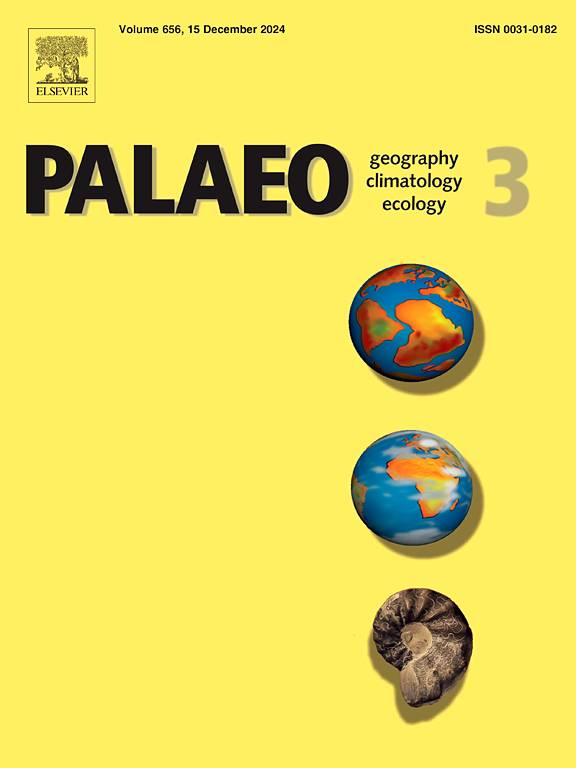UPb CA-ID-TIMS年代学约束下峨眉山大火成岩省喷发后玄武岩风化
IF 2.7
2区 地球科学
Q2 GEOGRAPHY, PHYSICAL
Palaeogeography, Palaeoclimatology, Palaeoecology
Pub Date : 2025-02-01
DOI:10.1016/j.palaeo.2024.112666
引用次数: 0
摘要
峨眉山大火成岩省的喷发后玄武岩风化作用是造成全球早五间坪期降温的主要原因。然而,这一冷却事件的终点尚未得到评估,这阻碍了对气候和风化之间长期相互作用的进一步了解。在峨眉山火山景观中发现了丰富的厚质、高风化的玄武岩古土壤,为火山喷发后玄武岩风化提供了直接证据。利用CA-TIMS锆石UPb定年对古土壤和邻近凝灰岩进行测年,确定了强烈风化作用的开始和结束时间分别为~ 259.6 Ma和~ 253.4 Ma。强烈风化作用的发生与五家坪期早期的冷却作用一致,支持峨眉山大火成岩省喷发后玄武岩风化作用引发的co2强迫冷却模式。此外,长期风化与古气候和碳同位素记录之间的时间相关性表明,这种冷却可能持续到~ 253.4 Ma。本文章由计算机程序翻译,如有差异,请以英文原文为准。
Protracted post-eruptive basaltic weathering of the Emeishan large igneous province constrained by UPb CA–ID–TIMS geochronology
The post eruptive basaltic weathering of the Emeishan large igneous province is proposed to cause early Wuchiapingian cooling globally. However, the endpoint of this cooling event has not been evaluated yet, preventing the further understanding of long-term interaction between climate and weathering. In this study, abundant thick and highly weathered basaltic paleosols at the Emeishan volcanic landscapes have been identified, providing direct evidence for intense post-eruptive basaltic weathering. By using CA-TIMS zircon U![]() Pb dating on paleosols and adjacent tuffs, the onset and the termination of the intense weathering are constrained to ∼259.6 Ma and ∼ 253.4 Ma, respectively. The onset of intense weathering is coincident with the early Wuchiapingian cooling, supporting the CO2-forced cooling model triggered by the post-eruptive basaltic weathering of the Emeishan large igneous province. Moreover, the temporal correlation between the long-term weathering and the paleoclimate and carbon isotope records indicate that this cooling is possible persisting until at ∼253.4 Ma.
Pb dating on paleosols and adjacent tuffs, the onset and the termination of the intense weathering are constrained to ∼259.6 Ma and ∼ 253.4 Ma, respectively. The onset of intense weathering is coincident with the early Wuchiapingian cooling, supporting the CO2-forced cooling model triggered by the post-eruptive basaltic weathering of the Emeishan large igneous province. Moreover, the temporal correlation between the long-term weathering and the paleoclimate and carbon isotope records indicate that this cooling is possible persisting until at ∼253.4 Ma.
求助全文
通过发布文献求助,成功后即可免费获取论文全文。
去求助
来源期刊
CiteScore
5.90
自引率
10.00%
发文量
398
审稿时长
3.8 months
期刊介绍:
Palaeogeography, Palaeoclimatology, Palaeoecology is an international medium for the publication of high quality and multidisciplinary, original studies and comprehensive reviews in the field of palaeo-environmental geology. The journal aims at bringing together data with global implications from research in the many different disciplines involved in palaeo-environmental investigations.
By cutting across the boundaries of established sciences, it provides an interdisciplinary forum where issues of general interest can be discussed.

 求助内容:
求助内容: 应助结果提醒方式:
应助结果提醒方式:


